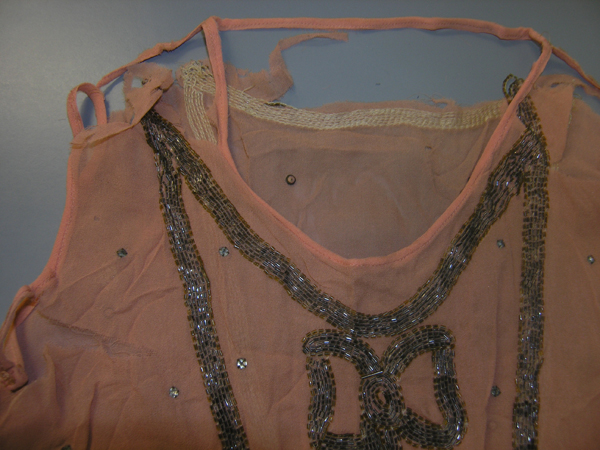The FIDM Museum Conservation Collection
Careful storage and handling is key to the preservation of any museum collection. In this post, Christina Johnson discusses how garments, textiles and accessories can be harmed by inappropriate storage materials. Before recently taking on the position of Associate Curator, Christina Johnson was the FIDM Museum Collections Manager for seven years.
The FIDM Museum Conservation Collection is a collection of problematic storage materials and non-accessioned damaged objects, as well as pieces with inherent vice. It is used to instruct people about museum collections management and preventative conservation for garments, accessories, and textiles. I founded this collection at the FIDM Museum after learning a great deal from a similar group of items used as part of my New York University Costume Studies graduate conservation class, taught by Chris Paulocik, Conservator at The Costume Institute, Metropolitan Museum of Art. FIDM Museum staff members use The Conservation Collection when teaching community workshops focused on the basic care and handling of costume and textiles. These hands-on teaching tools are beneficial not only to fellow museum employees who wish to learn storage basics, but also to people who care for family collections of cherished heirloom garments.
What follows is a selection of storage materials and damaged objects comprising a portion of the Conservation Collection. These pieces have either been de-accessioned out of our Permanent Collection, or donated to us over the years. Museum storage standards are constantly evolving. What might be thought of as archival storage or appropriate use in the past, such as modeling museum garments, or allowing non-museum professionals to exhibit pieces, is no longer acceptable in our field. One of the shoes below was displayed in sunlight for an extended period of time, while the other was not, accounting for the extreme color discrepancy between the pair.
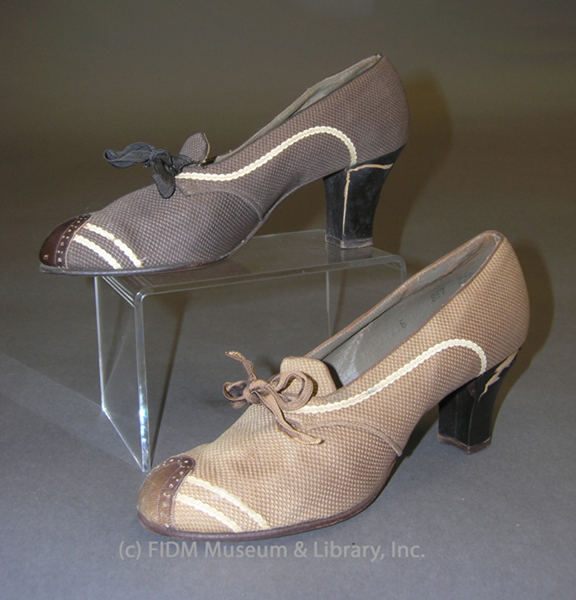
Shoes with light damage, 1940s, FIDM Museum Conservation Collection
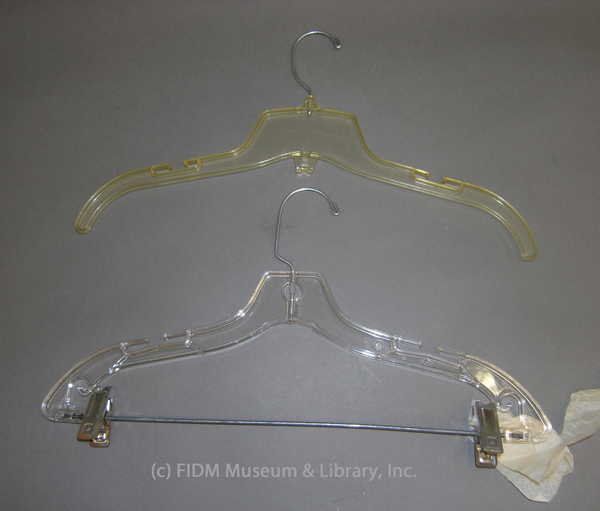
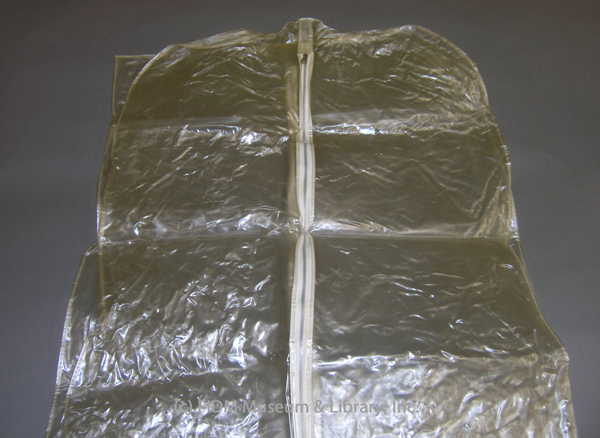
Garment bag and plastic hangers, FIDM Museum Conservation Collection
Just because a storage material is described as “archival,” “acid-free,” or “museum quality,” doesn’t mean it is appropriate for archival use. Contact a trained conservator for suggestions and purchase supplies from reputable sources. The garment bag pictured above is marketed as something beneficial for clothing storage. But because it is a type of polyvinyl chloride (PVC) it breaks down and becomes discolored and sticky. Hangers one might use in your own personal closet are not appropriate for museum objects. These plastic hangers outgas and turn yellow after only a few years.
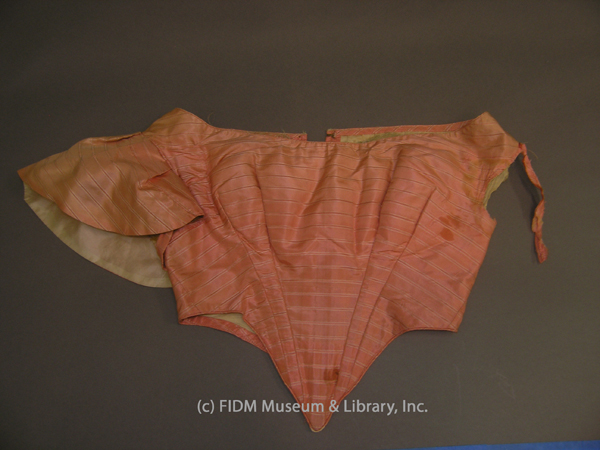
Bodice with light and wear damage, c. 1863, FIDM Museum Conservation Collection
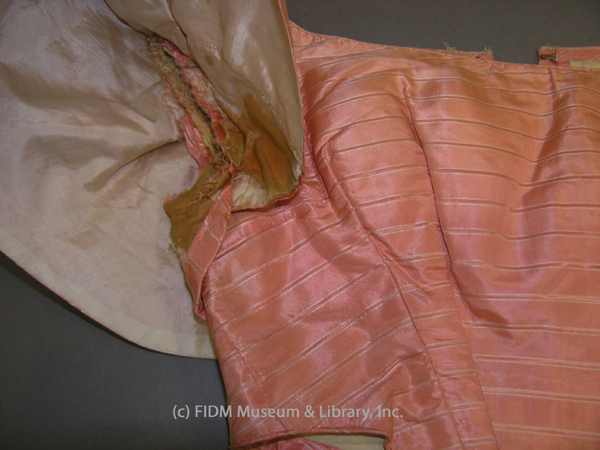
Detail of bodice underarm damage
This circa 1863 bodice (with later alterations) has extensive light and wear damage. Light is detrimental to garments because it embrittles fibers and causes extreme and irreversible discoloration. Notice the shoulder portion of the bodice is much lighter than the rest. This is because light shone on the garment from directly above (either on exhibition or in a lighted closet). The bodice was worn and repaired sometime during the mid to late 20th century, as can be observed by the remnants of iron-on adhesive, likely used to mask underarm perspiration stains.
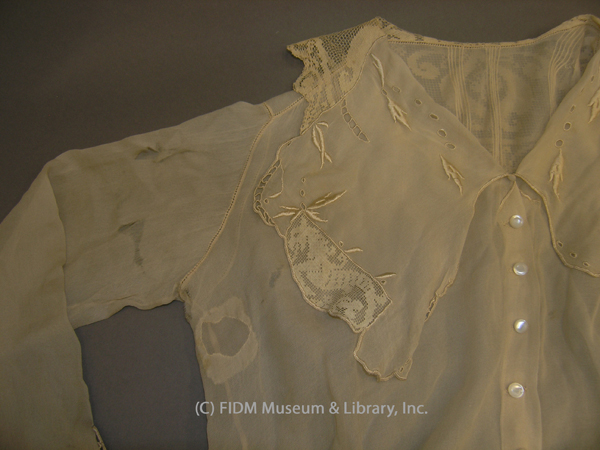
Blouse damaged by hanger, c. 1917, FIDM Museum Conservation Collection
Items that are fragile, heavily-beaded, or cut on the bias should never be stored hanging. Instead, they should be boxed in archival boxes, using tissue to support any folds. Sheer fabrics rip, beaded garments sag under the weight of their ornamentation, and bias cut gowns stretch. The chiffon and lace blouse pictured above was hung, causing holes in the delicate fabric.

Dress damaged by hanger, c. 1926, FIDM Museum Conservation Collection
The sad, shredded remnants of a beaded “flapper” dress testify to the fact that these garments should never hang in museum storage or be worn of they are to be preserved.
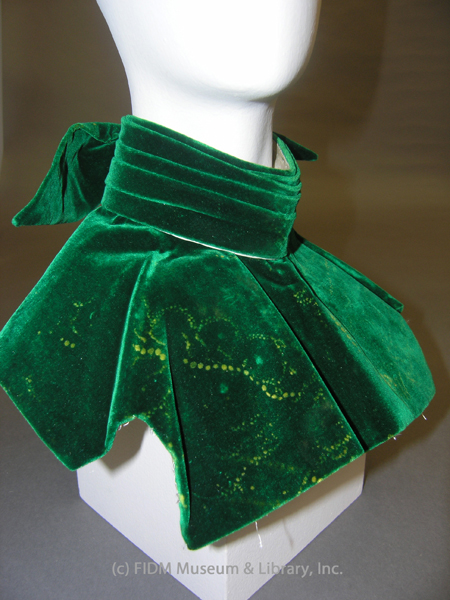
Dickie damaged by bead trim, c. 1895, FIDM Museum Conservation Collection
Damage can occur to boxed garments just as often as those that are stored hanging. It is important to interleave tissue between garments to prevent the transfer of soil or sizing from one item to its box mate. Decorative elements, such as beads, can react with fabric, as happened to this dickie. Chemically unstable beads, perhaps from the ensemble’s bodice, came in contact with the bright green velvet, creating a scalloped yellow pattern in the pile.
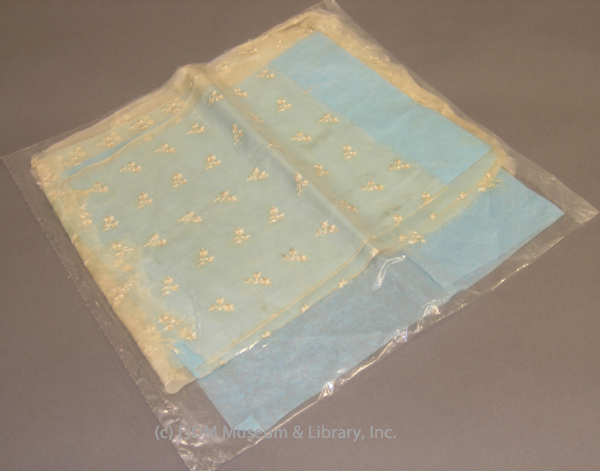
Lace and blue tissue, FIDM Museum Conservation Collection
Tissue absorbs body oil and dirt from the items it comes in contact with. Using archival grade tissue and changing it out periodically is vital for the preservation of garments and accessories. A vogue for storing heirloom lace in blue tissue started in the early 20th century and we still see lace stored this way when prospective donations are brought to our museum office. Not only is this tissue far from PH neutral, the blue dye would leach onto the lace if moistened. The lace has been wrapped in plastic, perhaps to guard from dust. Encasing these objects in plastic creates a micro-climate that easily becomes humid and supports the growth of mold.
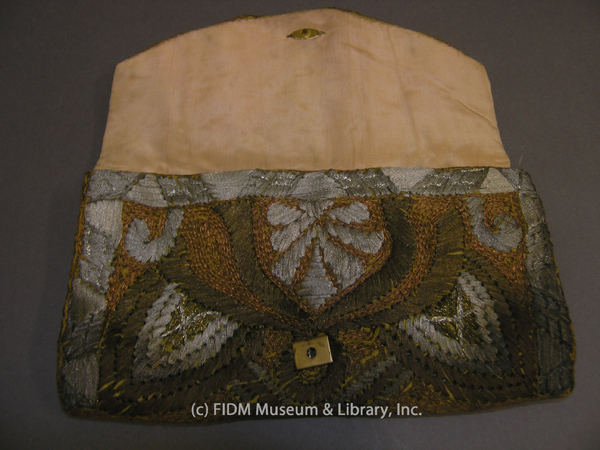
Purse with oxidation damage, 1930s, FIDM Museum Conservation Collection
Minimizing handling and wearing gloves to examine and display artifacts is a must, especially when metal is involved. Metal oxidizes and tarnishes when in contact with air and body oil. The metallic thread embroidery on this purse has not tarnished where covered by the flap. This hidden section has not been exposed to as much oxygen or handling as the exterior portion of the purse.
For more information on archival storage principles see:
Canadian Conservation Institute Notes
Your Vintage Keepsake: A Costume Society of America Guide to Costume Storage and Display
